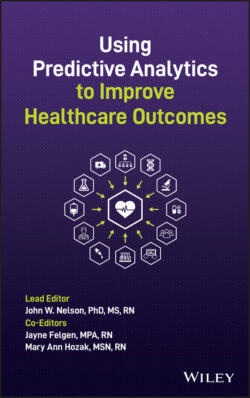Читать книгу Using Predictive Analytics to Improve Healthcare Outcomes - Группа авторов - Страница 42
Frameworks of Care
ОглавлениеIt is important to distinguish a theory of caring from a framework of care. Typically a framework of care is based on one or more caring theories. What makes a framework different is that it includes a methodology for the theory to take hold in all of the structures, processes, policies, and people in an organization. A framework of care is designed to see to it that a theory of care, with its concomitant behaviors, becomes pervasive throughout a system. As mentioned, the two frameworks discussed in this book are Relationship‐Based Care (RBC) and the Caring Behaviors Assurance System (CBAS).
Relationship‐Based Care (RBC) is a framework of care with eight dimensions:
1 Patient and Family (in the center of everything)
2 Healing Cultures
3 Leadership
4 Teamwork
5 Interprofessional Practice
6 Care Delivery
7 System Design
8 Evidence
Like many frameworks of care, RBC engages staff councils in embedding its principles into the structures, processes, policies, and people in the organization. Most of the case studies in this book were carried out in organizations that practice RBC. Operationalization of the RBC model uses the powerful formula for change outlined in the book I2E2: Leading Lasting Change (Felgen, 2007) as it is key to a successful transformation. Appendix B offers a description of the I2E2 formula.
Another framework of care, which is reviewed at length in the international section of this book, is the Caring Behaviors Assurance System (CBAS). CBAS has six dimensions, which are based on the “7 Cs” derived from a 2010 paper published by the Scottish government, called The Healthcare Quality Strategy for NHSScotland [sic]. You will see that two of the 7 Cs are combined in the first dimension:
1 Care and Compassion
2 Communication
3 Collaboration
4 Clean Environment
5 Continuity of Care
6 Clinical Excellence
The chief difference between RBC and CBAS is that the CBAS framework seeks cultural change entirely through the implementation of behavioral changes for staff members. It is a framework, rather than a theory, because, like RBC, it engages staff members in embedding these behavioral changes in the structures, processes, policies, and people in the organization.
Unlike RBC, CBAS has an extensive method of measuring the degree to which the concepts of caring are taking hold in practice, employing three separate measures, including an assessment of how job satisfaction is being impacted by its implementation. Having a rigorous method of measurement specified for a framework of care helps advance and sustain the framework of care in several ways. It identifies (a) what specific components of the framework can be shown to relate to improved outcomes, (b) what components of the framework are critical for staff members to embrace in order to enact the framework of care, and (c) where the important components of the framework are working well within the organization and where they need additional support. The measurement process for CBAS accomplished all of these things. Implementation of CBAS in 18 hospitals in Scotland is reviewed in detail in Chapter 18.
There are several frameworks of care that are not included in this book but are reported in the literature. Sometimes frameworks are adopted in name only or amended dramatically for specific contexts. For example, the term patient‐centered care is a general term proposed by the Institute of Medicine (IOM), which it defines as “providing care that is respectful of, and responsive to, individual preference, needs, and values, and ensuring that patient values guide all clinical decisions” (IOM, 2001, p. 5). This term is applied to a wide variety of models developed for specific organizations. Examples include the Cleveland Clinic's use of the IOM definition to create its own organization‐specific patient‐centered framework of care (Smith, 2018). Some companies have helped implement specific frameworks also termed patient‐centered care. For example, Planetree has a number of methods to help organizations implement and become certified in a framework of patient‐centered care (Planetree, 2020). Livestrong, a nonprofit organization which provides support for people with cancer, worked with the consulting firm Upstream to develop yet another framework of patient‐centered care (Upstream, 2020). And finally, the Health Education of England (HEE), an agency within the National Health Service (NHS) of England, provides support to implement what it also calls patient‐centered care (HEE, 2020).
Some theorists assert that Watson's Theory of Transpersonal Caring (2008a) is a framework of care when the processes of caring behaviors are taught with the intention that they be carried out within operations of care. While the implementation of any processes of caring in the absence of structures, processes, and policies to support the sustaining of the behaviors cannot be called a framework of care, the implementation of Watson's caring behaviors is an integral part of several frameworks of care delivery.
